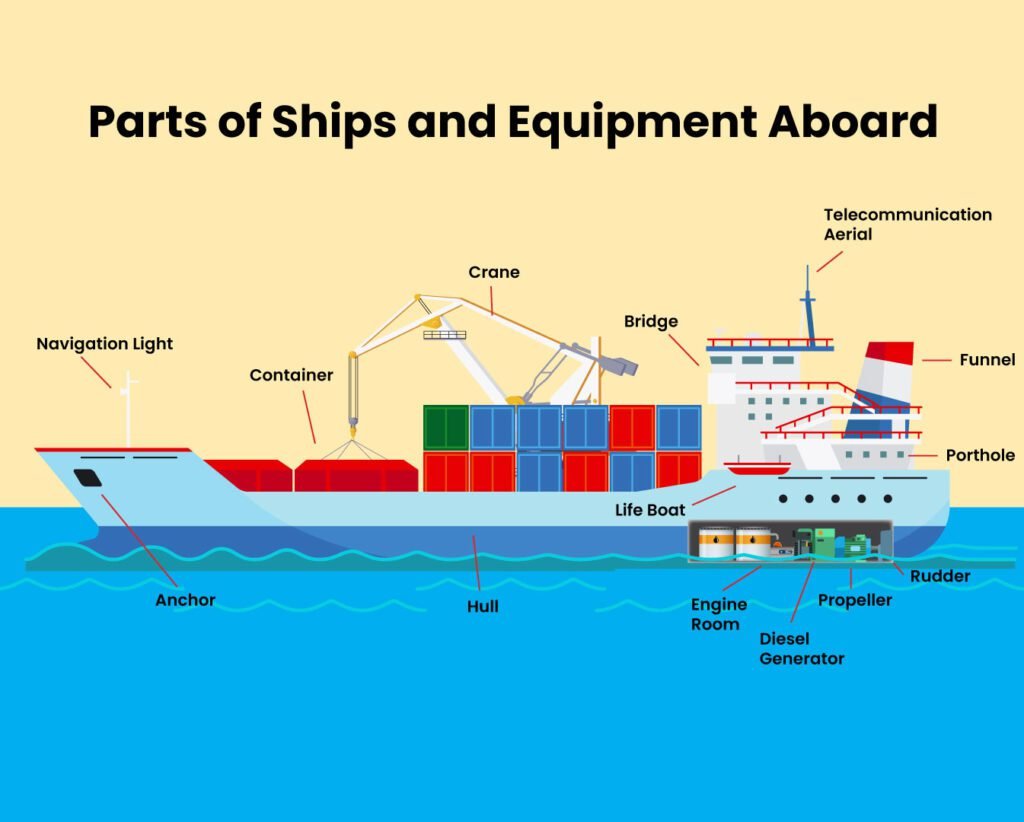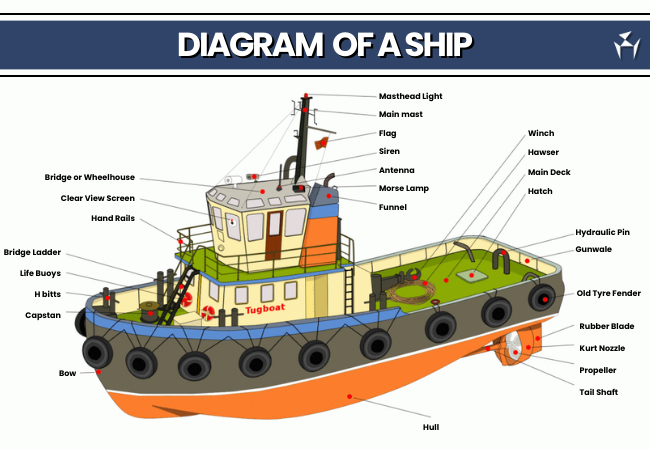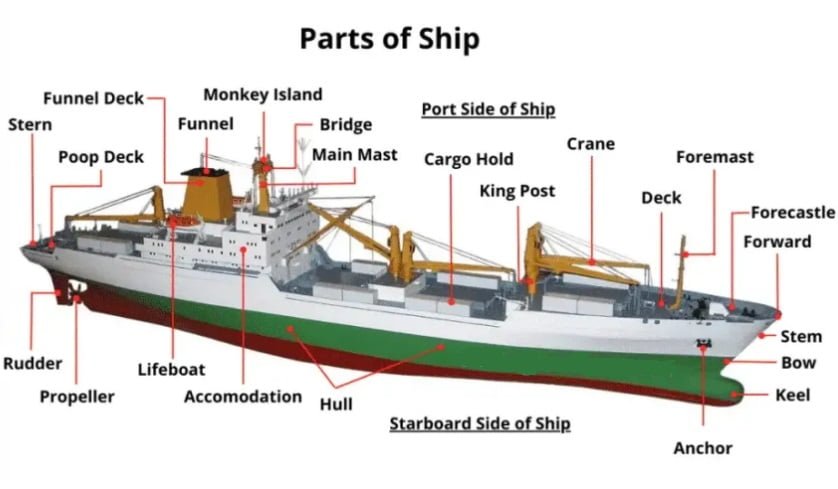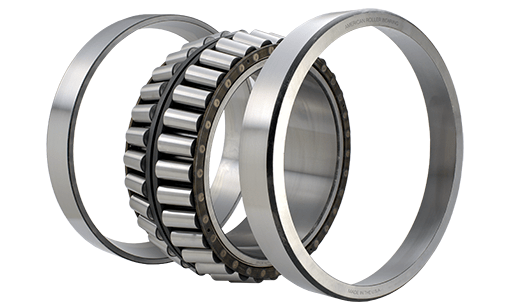Ships, whether for transporting goods or people, are intricate machines requiring a sophisticated combination of design, engineering, and construction. Understanding the various parts of a ship is crucial to ensuring smooth navigation and safe transport.
The anatomy of a ship consists of multiple parts, each with its distinct purpose and function. These parts include the hull, superstructure, propulsion system, navigation and communication equipment, cargo handling equipment, safety equipment, electrical systems, and plumbing and sanitation systems. Knowing how each of these components works is essential in comprehending the ship’s anatomy, construction, and systems.
From the bow to the stern, ships’ parts come in various shapes, sizes, and materials. The design and construction of the vessel must consider its purpose, route, and intended use. Every component plays a vital role in the ship’s overall functionality, stability, and efficiency.
As we explore these ship parts and systems in detail, you will gain a better understanding of how they work together to ensure smooth maritime navigation and efficient transport of goods and people. So, let’s dive into the fascinating world of ship anatomy and construction!

Ship Hull
The ship hull is the main body of the vessel that provides buoyancy and stability. It is the outermost layer and is responsible for withstanding the forces of the sea. The hull is made up of several components that work together to form a rigid and durable structure.
Hull Structure
The hull structure is made up of the bottom, sides, and deck of the ship. The bottom of the hull is called the keel, which runs the length of the ship and provides support and stability. The sides of the hull are called the plating or shell and are made of steel or aluminum to withstand the harsh marine environment. The deck is the top of the ship and provides a surface for crew and cargo.
Hull Components
The bow of the ship is the front and is designed to cut through the water efficiently. The stern is the back of the ship and provides propulsion and steering. The rudder, which is attached to the stern, provides directional control. The propeller is also attached to the stern and provides the force needed for movement. The hull also contains various openings such as hatches, vents, and portholes for access and ventilation.
Ship Superstructure: The Brain and Housing of the Vessel
A ship’s superstructure is the upper part of the ship above the main deck, which includes the bridge, deckhouse, and accommodations for the crew and passengers. It serves as the brain and housing of the vessel, containing essential systems and equipment necessary for safe and efficient navigation.
The Bridge
The bridge is the command center of the ship and is located at the front of the superstructure. It provides a panoramic view of the ship’s surroundings and serves as the primary control station for navigation, communication, and maneuvering. The bridge is equipped with essential instruments such as radar, GPS, and compasses, which provide real-time data on the ship’s position, speed, and direction.
The Deckhouse
The deckhouse is the main living quarters for the crew and is located behind the bridge. It provides sleeping quarters, a galley, mess hall, and other amenities necessary for the crew’s comfort and well-being during long voyages. The deckhouse may also house other equipment and systems, such as the ship’s fire control center and emergency equipment storage.
Accommodations
The accommodations area is located towards the rear of the superstructure and includes cabins or living quarters for the crew and passengers. These quarters can range from shared rooms to private suites with en-suite bathrooms. The area also includes common areas such as lounges, recreational areas, and medical facilities.
The ship’s superstructure is critical in providing a safe and comfortable environment for the crew and passengers during long voyages. It is also responsible for housing and protecting the essential systems and equipment necessary for navigation, communication, and other ship operations.
Propulsion System
One of the most essential systems onboard a ship is the propulsion system, which provides the necessary power to move the vessel through the water. The propulsion system consists of various components, including the engine room, propellers, and engines.
Engine Room
The engine room is typically located in the lower part of the ship and houses the ship’s engines, generators, and other machinery. It is a critical area that requires constant monitoring and maintenance to ensure the ship’s smooth operation. The engine room is also where the crew can perform repairs and maintenance on the ship’s machinery.
Propellers
Propellers are essential components of a ship’s propulsion system, generating the force that moves the vessel forward or backward. The number and size of the propellers vary depending on the ship’s size and design, and they are typically located at the stern of the ship.
Engines
The type of engine used in a ship depends on the ship’s size, speed, and power requirements. Common types of engines include diesel engines, steam turbines, and gas turbines. They are typically located in the engine room and are responsible for generating the power to turn the propellers and move the ship through the water.

Navigation and Communication Equipment
Navigation and communication equipment are critical systems on any ship, ensuring safe navigation and effective communication with other vessels and shore.
One of the most important pieces of navigation equipment on a ship is radar, which uses radio waves to detect nearby objects. The radar system consists of a transmitter, receiver, and display screen, and it is used to detect and track other vessels and obstacles on the water.
GPS (Global Positioning System) is another essential tool for navigation. It uses satellites to determine a ship’s exact location and provides information such as speed, direction, and distance to other locations.
Communication equipment on a ship includes radios, which allow for communication with other vessels and shore stations. In addition, a ship’s communication system may include satellite phones, email, and other forms of electronic communication.
Most ships also have a bridge navigation system, which integrates radar, GPS, and other navigation tools into a centralized display. This allows for easier navigation and better situational awareness for the ship’s crew.
Risk Management
Effective navigation and communication are critical components of risk management on a ship. By using radar, GPS, and other tools, a ship’s crew can avoid collisions with other vessels and hazards such as reefs and rocks. In addition, effective communication can be the key to obtaining assistance during an emergency.
For these reasons, navigation and communication equipment are among the most important systems on any vessel, and they require careful maintenance and attention to ensure their proper functioning.
Cargo Handling Equipment
The cargo handling equipment on a ship is an essential component of its operations. It allows for the efficient loading, unloading, and securing of cargo, ensuring the timely delivery of goods. The main components of a cargo handling system include cranes and cargo holds.
Cranes
Cranes are used to hoist cargo on and off the ship. They are typically mounted on the ship’s deck and come in various sizes and types. Some cranes are designed to lift heavy loads, while others are more suitable for lighter cargo. Cranes can also be operated manually or electronically, depending on the ship’s specifications.
Modern cargo handling cranes use hydraulic or electric power for their operation. Hydraulic cranes rely on fluid pressure to lift and move heavy loads, making them ideal for handling heavy cargo. Electric cranes use electric motors for movement and are best suited for lighter loads.
Cargo Holds
The cargo hold is the area where the cargo is stored during transportation. It is typically located below the main deck and can be accessed through large doors on the ship’s hull. Cargo holds must be designed to accommodate various types of cargo while ensuring the safety of crew members and the ship.
The cargo hold must also be equipped with various systems to ensure the safety of the cargo during transportation. This includes systems for securing the cargo, monitoring its temperature and humidity, and preventing damage during rough seas.
In summary, the cargo handling equipment on a ship is vital to its operations. The cranes and cargo holds work together to ensure the timely delivery of cargo while maintaining the safety of the crew and the ship.
Safety Equipment
While ships are designed with safety in mind, accidents can still happen at sea. That’s why it’s crucial for ships to have appropriate safety equipment on board. Let’s take a look at some of the most important safety equipment found on ships:
Lifeboats and Life Rafts
Lifeboats and life rafts are essential pieces of safety equipment that are designed to keep passengers and crew members safe in the event of an emergency. Lifeboats can be launched from the deck of the ship and are typically equipped with oars and a motor to help them maneuver in the water. Life rafts are inflatable rafts that can be stored on deck and deployed when needed.
Fire Suppression Systems
Fires can be extremely dangerous on board a ship. That’s why many ships are equipped with fire suppression systems that can help to quickly extinguish any flames that might break out. These systems typically use water, foam, or gases to put out fires.
Emergency Position Indicating Radio Beacons (EPIRBs)
If a ship goes down or becomes stranded at sea, it’s essential for rescuers to be able to locate the ship and its passengers quickly. EPIRBs are small devices that can be activated in an emergency, sending out a distress signal that can be picked up by rescue teams. These devices are typically waterproof and can be attached to life jackets or other safety equipment.
Personal Flotation Devices (PFDs)
Whenever someone is on board a ship, it’s important for them to have a PFD readily available. PFDs are designed to keep a person afloat in the water and can be used to help someone stay safe while waiting for rescue. PFDs come in many different styles, including vests and inflatable devices.
These are just a few of the many safety features that can be found on modern ships. By ensuring that a ship is equipped with the appropriate safety equipment, crew members and passengers can sail with confidence and peace of mind.

Electrical Systems
Ship electrical systems are crucial for powering various components and systems on board, ranging from navigation and communication equipment to cargo handling mechanisms and safety systems. These systems are responsible for generating and distributing electricity throughout the vessel, ensuring that all areas receive the power necessary to operate effectively.
Power Generation
The power generation process begins in the engine room, where generators are used to convert mechanical energy into electrical energy. The size and number of generators depend on the ship’s size and power requirements.
On most vessels, generators are powered by diesel engines, although some ships may also use gas turbines or other alternative fuel sources. Once generated, electricity is distributed to different parts of the ship through a network of wires and cables.
Wiring and Distribution
Ship electrical systems rely on a complex network of wiring and distribution panels to transport electricity throughout the vessel. These wiring systems are designed to handle high levels of power and must be able to withstand the harsh marine environment without corroding or degrading.
Electrical distribution panels are used to regulate the flow of electricity to different parts of the ship, ensuring that each system receives the appropriate amount of power. These panels are often located in the engine room or other central locations on the vessel.
Lighting
Ship lighting is an essential component of the vessel’s electrical systems. Adequate lighting is necessary for maintaining safe navigation, ensuring that crew members can see and operate machinery and equipment effectively.
LED lighting fixtures are becoming increasingly popular in ship design due to their energy efficiency and longer lifespan compared to traditional lighting sources. Some vessels may also use colored lighting to assist with nighttime navigation or signaling.
Plumbing and Sanitation Systems
The plumbing and sanitation systems on board a ship are crucial for ensuring the health and wellbeing of the crew members. Proper maintenance and operation of these systems are essential for the efficient and safe operation of the vessel.
The ship’s plumbing system is responsible for supplying fresh water to all areas of the vessel. It includes various pipes, pumps, and valves that must be maintained and inspected regularly. Any leaks or malfunctions in the plumbing system can lead to water damage, loss of fresh water supply, or even flooding.
In addition to supplying fresh water, the ship’s plumbing system also handles wastewater and sewage. Sanitation systems on board the vessel are crucial for managing this waste and preventing pollution of the surrounding environment. Wastewater treatment systems are used to filter and treat sewage, ensuring that it is safe to discharge into the ocean.
Proper hygiene practices on board the ship are also essential for preventing the spread of disease and maintaining a healthy living environment for crew members. Sanitation systems play a critical role in preventing the spread of germs and illnesses. Regular cleaning and maintenance of these systems help to ensure that they are operating effectively.
Overall, the plumbing and sanitation systems on board a ship are critical components that must be maintained and operated properly. Failure to do so can result in serious consequences for the crew members and the environment. By adhering to proper maintenance and operating procedures, ship operators can ensure that these vital systems operate effectively and safely.
Conclusion
In conclusion, understanding the various parts of a ship is crucial for maritime navigation and safety. Ship parts such as the hull, superstructure, propulsion system, navigation and communication equipment, cargo handling equipment, safety equipment, electrical systems, and plumbing and sanitation systems all play essential roles in ensuring a ship operates efficiently and safely.
By familiarizing oneself with vessel parts and maritime terminology, one can gain a greater appreciation for the complexity of ship structure and construction. Additionally, this can provide insight into the importance of regular maintenance and upkeep to ensure the ship’s systems are functioning optimally.
Whether one is a professional mariner or simply interested in ships and maritime travel, knowledge of ship anatomy and systems is a valuable asset. We hope this detailed guide has been informative and helpful in providing a comprehensive overview of the various parts of a ship.
FAQ
Why is it important to understand the different parts of a ship?
Understanding the different parts of a ship is important because it allows for better navigation, maintenance, and overall operation of the vessel. It helps ensure the safety of the crew, passengers, and cargo onboard.
What is the ship’s hull and what is its purpose?
The ship’s hull is the outer shell or body of the ship. It provides structural strength, buoyancy, and protection against the elements. The hull also helps to minimize water resistance and provides stability to the ship.
What components make up the ship’s hull?
The ship’s hull is made up of various components, including the bow (front), stern (rear), keel (bottom), bulkheads (internal walls), and frames (ribs). These components work together to form the overall structure of the ship.
What is the superstructure of a ship?
The superstructure of a ship includes the bridge, deckhouse, and accommodations. It is located above the main deck and houses essential equipment, navigation systems, and provides living quarters for the crew.
What is the propulsion system of a ship?
The propulsion system of a ship is responsible for generating the power needed to move the vessel through water. It typically includes engines, propellers, and various supporting systems like fuel storage and cooling.
What navigation and communication equipment are found on ships?
Ships are equipped with navigation systems such as radar, GPS, and compasses to determine their position and navigate safely. Communication equipment includes radios, satellite systems, and other technologies for effective communication with shore and other vessels.
What is cargo handling equipment on a ship?
Cargo handling equipment refers to the machinery and systems used to load, unload, and secure cargo on a ship. This includes cranes, cargo holds, conveyor belts, and other mechanisms that ensure efficient cargo operations.
What safety equipment is found on ships?
Ships are equipped with various safety measures, including lifeboats, life rafts, fire suppression systems, emergency lights, and alarms. These are in place to protect the crew and passengers in case of emergencies.
What are the electrical systems on a ship?
Electrical systems on ships include power generation, distribution, wiring, and lighting. They provide power to various components and systems on board, ensuring the proper functioning of navigation equipment, communication systems, and other electrical devices.
What plumbing and sanitation systems are found on ships?
Ships have plumbing systems that provide water supply, wastewater treatment systems, and facilities for maintaining hygienic conditions onboard. These systems are essential for the well-being and comfort of the crew and passengers.
Check Out Other Important Topics
| IC Engine | Important PDFs | Boilers | Synergy Maritime Exam | Naval Arch | MEO Class 4 |
| Interview Questions | Difference Between | Types of Pumps | Auxiliary Machines | Types of Valves | Home |



